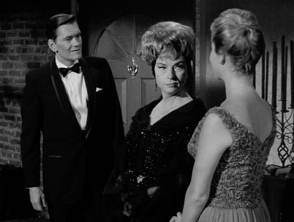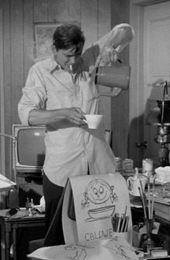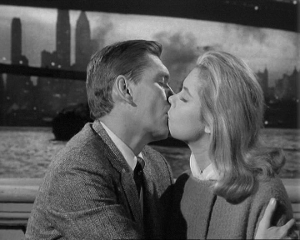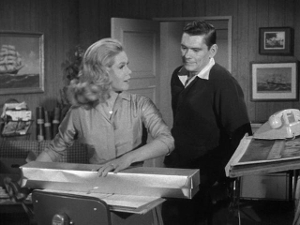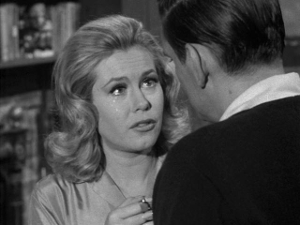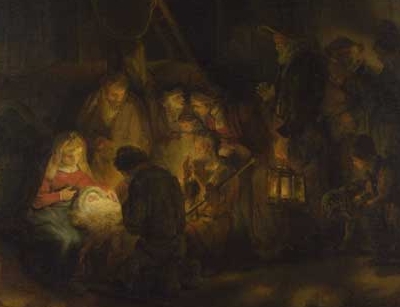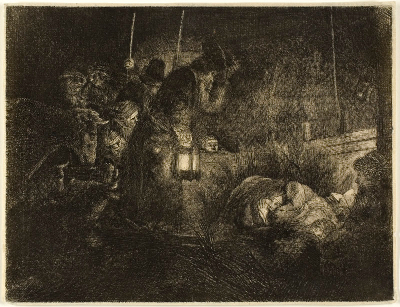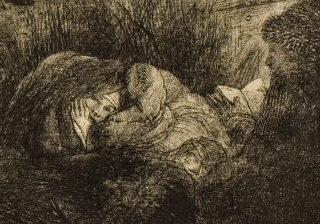In Vocation
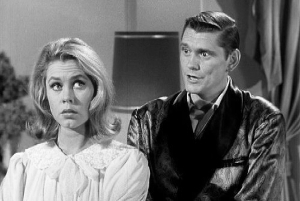 What does everyone know about Bewitched? It's about a free-spirited young witch whose uptight husband does everything he can to suppress her natural inclinations to magic.
What does everyone know about Bewitched? It's about a free-spirited young witch whose uptight husband does everything he can to suppress her natural inclinations to magic.
No. It's not.
Go back to the first season, before the show became focused on the farce, and you'll clearly see its theme. Abandon the feminist distortions and you'll see that Bewitched is about two newlyweds, thoroughly in love, who are trying to establish a normal, suburban life.
Witch and Wife
Monday, March 30, 2009 10:56 pm

No. It's not.
Go back to the first season, before the show became focused on the farce, and you'll clearly see its theme. Abandon the feminist distortions and you'll see that Bewitched is about two newlyweds, thoroughly in love, who are trying to establish a normal, suburban life.
Amid the Forests, Among the Stars
A Little Animism Might Help
Sunday, October 5, 2008 7:52 pm
When considering what has occupied thinkers until the modern age, it strikes me how unabashedly they ruminated on the non-material. For ancient and medieval thinkers, material things were not ultimate things, and truly ultimate things can and should be understood.
Modern materialists simply lack imagination. Maybe it is better to say that their imaginations cannot escape their machines and mathematics. Whatever strength of imagination they do have — to imagine, say, a warp in spacetime — they reject any concepts not reducible to the material.
Thus they are terribly hampered when it comes to thinking about the supernatural, let alone believing in God. Indeed, unlike the rest of us, they have no sense of the Divine. Perhaps they truly lack this sense. Rather than having plucked out their eyes, they were simply born blind. Either way, is it not amusing how they think themselves superior for being handicapped? It never occurs to them that they are in a minority not because they, as an elite, have transcended mankind, but because they are simply damaged.
Modern materialists simply lack imagination. Maybe it is better to say that their imaginations cannot escape their machines and mathematics. Whatever strength of imagination they do have — to imagine, say, a warp in spacetime — they reject any concepts not reducible to the material.
Thus they are terribly hampered when it comes to thinking about the supernatural, let alone believing in God. Indeed, unlike the rest of us, they have no sense of the Divine. Perhaps they truly lack this sense. Rather than having plucked out their eyes, they were simply born blind. Either way, is it not amusing how they think themselves superior for being handicapped? It never occurs to them that they are in a minority not because they, as an elite, have transcended mankind, but because they are simply damaged.
Ages as Bright as Any
Michael Flynn's Eifelheim
Saturday, June 21, 2008 9:37 pm
In seeking science fiction that is neither left-wing nor Christophobic, I would have thought the worst place to look would be in a novel about aliens crashing in a medieval German town. O! the opportunities to condemn the superstitious villainies of the Dark Ages! Beleaguered aliens — so like ourselves in their adherence to Science! — against the base and ignorant Catholicism of dim-witted villagers! Goodness me, the cliches write themselves.
Eifelheim is absolutely nothing like that. This is a work that depicts medieval Catholics with sympathy, not by supposing them to be unwashed Episcopalians who would vote Democratic if only they could, but by eschewing condescension and hatred — and, more to the point, by depicting the faithful Catholics as fully rational.
Eifelheim is absolutely nothing like that. This is a work that depicts medieval Catholics with sympathy, not by supposing them to be unwashed Episcopalians who would vote Democratic if only they could, but by eschewing condescension and hatred — and, more to the point, by depicting the faithful Catholics as fully rational.
Deckard Is Not a Replicant
No Matter What Ridley Scott Thinks
Saturday, May 24, 2008 6:00 pm
Blade Runner is about memory and mortality: memory as the fountain of genuine life; mortality as the completion of memory.
An Interruption of the Wallpaper
The Emptiness of Rothko
Saturday, February 2, 2008 4:42 am
I am an optimist. I believe that foolish forms of art endure only so long as they are a means to self-elevation. Once it is no longer the Mark of the Smart Set to gush about a certain sort of art, that art will be abandoned.
A Bourne Rumination
On the Last of the Trilogy
Sunday, January 13, 2008 3:52 pm
Beware! Spoilers follow.
I can watch the first two Bourne movies repeatedly and still enjoy them. They really do succeed. In general I am annoyed that they, like too much out of Hollywood, find the greatest criminality among American spies; but hey, they are exciting and they aren't cartoons. Having heard that The Bourne Ultimatum was even more anti-American, I wasn't so sure I wanted to bother with it; yet I had also heard it was very good, and so I got it.
Yes, yes, one could argue that it's not anti-American as such but only anti-CIA; but, in the end, it is Americans who are the bad guys, so it's a bit sour. It also spins its wheels a bit, as far as the action goes; the variations on a theme were sometimes not so variant. Still, I really liked it — and unlike, say, Spider-Man 3, it doesn't crater and ruin its trilogy, but finishes things very well.
Now, two observations.
I can watch the first two Bourne movies repeatedly and still enjoy them. They really do succeed. In general I am annoyed that they, like too much out of Hollywood, find the greatest criminality among American spies; but hey, they are exciting and they aren't cartoons. Having heard that The Bourne Ultimatum was even more anti-American, I wasn't so sure I wanted to bother with it; yet I had also heard it was very good, and so I got it.
Yes, yes, one could argue that it's not anti-American as such but only anti-CIA; but, in the end, it is Americans who are the bad guys, so it's a bit sour. It also spins its wheels a bit, as far as the action goes; the variations on a theme were sometimes not so variant. Still, I really liked it — and unlike, say, Spider-Man 3, it doesn't crater and ruin its trilogy, but finishes things very well.
Now, two observations.
Depicting Christ Anew
Encouragement From the Past
Sunday, May 27, 2007 1:54 am
How am I to say anything anew? For two thousand years, artists have been depicting Christ and what He was and is. Even if I am inclined — even if I am impelled — to express, in my fiction, an image of Christ, what fresh manner can I take? I am not clever enough; and my civilization is in its decadence: it offers no help; it has spent itself. At the end of our culture, all has been done and done.
© 2004-25 David Skinner · All rights reserved
